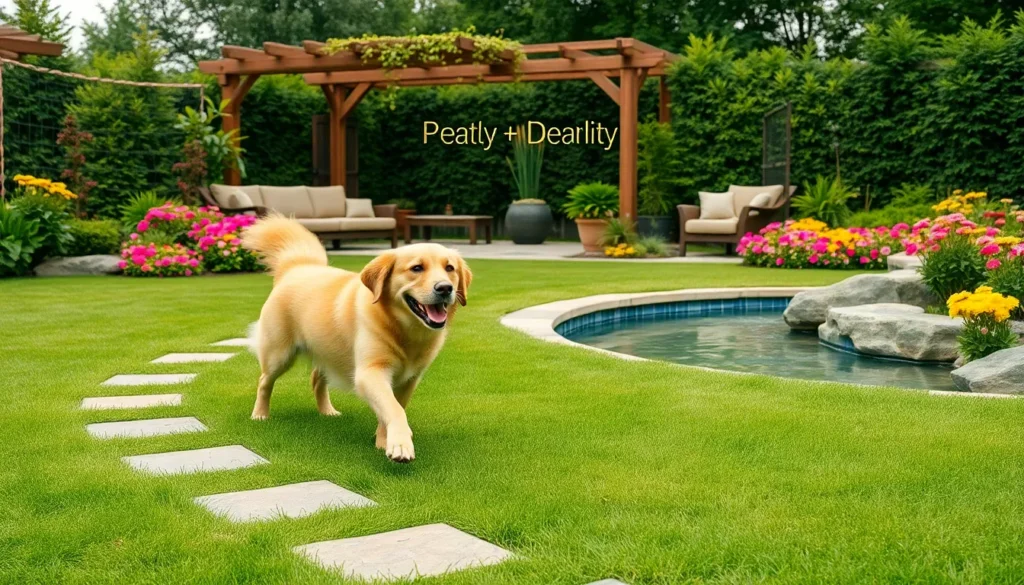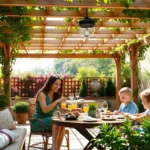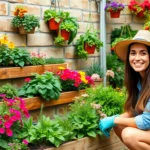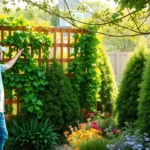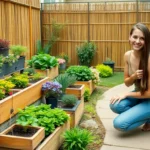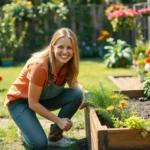Creating a beautiful garden that both you and your furry friend can enjoy doesn’t have to be a challenge. We understand the struggle of maintaining gorgeous outdoor spaces while keeping our beloved dogs safe and happy. That’s why we’ve compiled the most effective dog-friendly garden ideas that’ll transform your backyard into a paradise for both humans and pups.
Your garden can be stunning and functional when you know which plants to choose and which landscaping tricks actually work. We’ll show you how to design spaces that withstand playful paws while creating an environment where your dog can explore safely.
From selecting non-toxic plants that won’t harm curious nibblers to creating designated play areas that protect your prized flowers, these proven strategies will help you build the perfect outdoor sanctuary. Let’s jump into practical answers that’ll make your garden the envy of every dog owner in the neighborhood.
Create Safe Pathways and Walkways for Your Canine Companion
Strategic pathway design keeps our dogs safe while improving our garden’s overall functionality. Well-planned walkways prevent paw injuries and provide clear navigation routes for both pets and their owners.
Install Non-Slip Stepping Stones
Non-slip stepping stones create secure footing for dogs of all sizes throughout our garden spaces. We recommend choosing textured natural stone or concrete pavers with raised patterns that provide excellent traction even when wet. Place these stones 12-18 inches apart to accommodate different dog stride lengths comfortably.
Material Options and Spacing Guidelines:
| Stone Type | Texture Level | Best for Dog Size | Spacing Distance |
|---|---|---|---|
| Textured Concrete | High grip | All sizes | 12-15 inches |
| Natural Sandstone | Medium grip | Medium to large | 15-18 inches |
| Rubberized Pavers | Maximum grip | Senior dogs | 10-12 inches |
Position stepping stones along frequently traveled routes like pathways to water bowls, favorite resting spots, and entrance gates. Installing them at ground level prevents tripping hazards while maintaining a seamless garden appearance.
Design Wide Gravel or Mulch Trails
Wide trails accommodate multiple dogs walking side by side and allow comfortable passing space during playtime. We suggest creating pathways at least 4-6 feet wide using pet-safe materials like rounded river rock or organic mulch made from cedar or pine.
Choose gravel with smooth edges measuring 1/4 to 1/2 inch in diameter to protect sensitive paw pads. Avoid sharp crushed stone or large rocks that can cause discomfort or injury. Organic mulch options like shredded bark provide natural cushioning and excellent drainage while deterring weeds naturally.
Install industry edging along trail borders to maintain clean lines and prevent material spreading into planted areas. Regular maintenance involves raking gravel smooth and refreshing mulch seasonally to maintain optimal walking conditions.
Add Soft Ground Cover Along Main Routes
Soft ground cover plants create comfortable walking surfaces while adding visual appeal to our garden pathways. We recommend selecting low-growing, dog-tolerant options like creeping thyme, buffalo grass, or Irish moss that can withstand moderate foot traffic.
Plant these ground covers in strips alongside harder pathway materials to provide relief for tired paws during longer garden explorations. Buffalo grass works particularly well in sunny areas and requires minimal watering once established. Creeping thyme releases pleasant fragrance when stepped on and produces small flowers that attract beneficial pollinators.
Maintain ground cover health by watering during dry periods and trimming back overgrowth that might obstruct pathway visibility. These living carpets naturally suppress weeds while creating soft landing zones for playful dogs jumping off pathway surfaces.
Choose Dog-Safe Plants and Flowers for Your Garden

Building on our pathway foundation, we’ll now focus on selecting plants that keep our furry friends safe while maintaining garden beauty. Smart plant choices create stunning landscapes without compromising our dogs’ health and well-being.
Select Non-Toxic Flowering Plants
Camellias stand out as exceptional choices for dog-friendly landscaping because they’re both attractive and completely non-toxic. These evergreen shrubs produce gorgeous blooms in winter and spring while requiring minimal maintenance throughout the year.
Magnolias offer spectacular flowering displays known for their beauty and safety around pets. These trees create stunning focal points with their large, fragrant blossoms that won’t harm curious dogs who might investigate fallen petals.
Shrub roses like the Grace N’ Grit™ Pink variety provide beautiful blooms that are easy to care for and safe for our canine companions. These hardy plants deliver continuous color throughout the growing season while withstanding typical garden wear from active pets.
Sunflowers brighten up garden spaces without posing any risks to dogs who love to explore their surroundings. These cheerful giants create natural entertainment as they track the sun’s movement and attract beneficial wildlife to our yards.
Emerald Green Arborvitae provides dense hedging for screening and privacy while remaining completely safe for pets. These evergreen shrubs create natural boundaries that give dogs secure spaces to play without exposure to harmful plants.
Incorporate Pet-Friendly Herbs and Vegetables
Edible plants including organically grown fruits and vegetables offer dual benefits as they’re safe for dogs and provide fresh produce for our families. Carrots, green beans, and sweet potatoes make excellent additions that dogs can safely sample during garden exploration.
Ornamental grasses require low maintenance while remaining non-toxic to our pets throughout all seasons. These plants add texture and movement to garden designs while creating interesting sensory experiences for dogs who enjoy brushing against different textures.
Japanese Maples provide beautiful shade coverage and remain completely safe for dogs who seek cool resting spots during hot weather. These trees offer stunning seasonal color changes that enhance garden appeal while creating natural gathering areas for pets and families.
Fringe Flower delivers vibrant foliage and colorful blooms in warmer climates without posing any danger to curious dogs. This versatile plant adapts well to various growing conditions while maintaining its appeal throughout multiple seasons.
Avoid Poisonous Plants That Harm Dogs
Azaleas pose serious threats to dogs and should never be included in pet-friendly garden designs. These popular shrubs contain toxins that can cause severe illness or death if ingested by curious pets.
Oleander plants are extremely dangerous and must be avoided completely in households with dogs. Every part of this plant contains deadly toxins that can be fatal even in small quantities.
Lily plants of various species present important risks to pets and require immediate removal from dog-accessible areas. These flowers can cause kidney failure and other serious health complications in dogs who come into contact with any part of the plant.
Research the toxicity of any plant before introducing it to your garden space. Consulting with veterinarians and using reliable plant databases ensures we make informed decisions that protect our beloved pets while maintaining beautiful outdoor spaces.
Design Designated Play Areas for Active Dogs
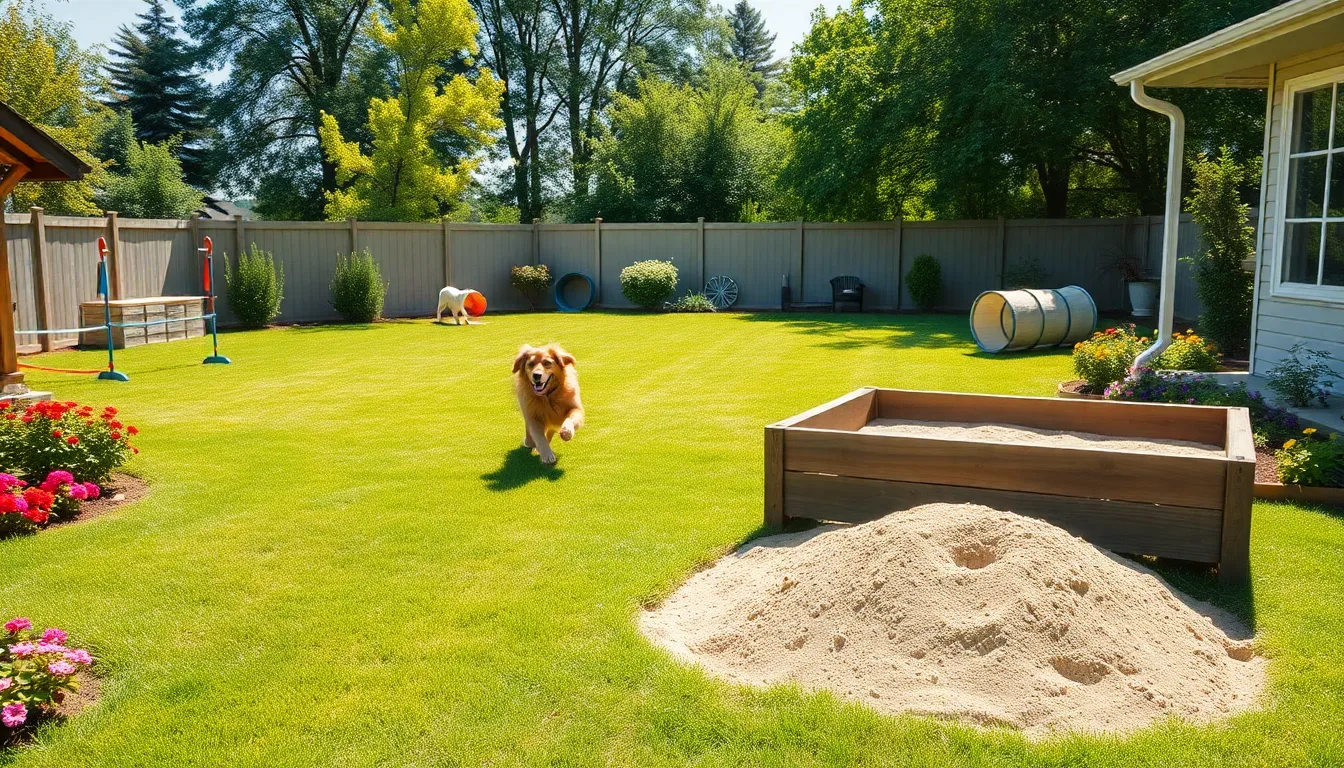
Creating exact zones for play transforms your garden into a structured environment that protects both vegetation and provides endless entertainment for your furry friends. Designated areas minimize disruption to flower beds while ensuring your dogs have dedicated spaces for their favorite activities.
Create Open Lawn Spaces for Running and Fetching
Open grassy areas serve as the foundation for any active dog’s paradise, providing ample room for running and fetch games without damaging delicate plants or flower beds. We recommend maintaining these spaces through regular mowing and monitoring for bare spots or soil compaction that can develop from frequent use. Well-maintained lawns encourage natural behavior and exercise while keeping obstacles to a minimum for safe play sessions.
Large breed dogs need approximately 30-40 square feet of open space for comfortable movement, while smaller breeds can thrive in 15-20 square foot areas. Position these zones away from fragile garden features and ensure proper drainage to prevent muddy conditions during wet weather. Regular overseeding helps maintain thick grass coverage that can withstand heavy paw traffic throughout the seasons.
Install Agility Equipment and Obstacles
Agility elements transform your garden into an interactive playground that provides both physical exercise and mental stimulation for dogs of all ages. Weather-resistant materials like treated wood, PVC pipe, and galvanized steel ensure your equipment withstands outdoor conditions year-round. Space jumps, tunnels, and weave poles at least 6 feet apart to allow for easy movement and safe navigation during training sessions.
Start with basic equipment like low jumps (6-12 inches high) and simple tunnels before advancing to more complex obstacles as your dog builds confidence. Professional agility equipment can cost $200-500 per piece, but DIY alternatives using PVC pipes and plywood offer budget-friendly options under $50 per obstacle. Consider your dog’s size and athletic ability when selecting equipment heights and spacing requirements.
Set Up Sandbox Areas for Digging
Sandboxes satisfy your dog’s natural digging instincts while protecting your carefully cultivated flower beds and lawn areas from destructive excavation. Clean, coarse sand works best for these designated digging zones, as it drains well and doesn’t compact like fine sand or clay soils. Regular maintenance prevents parasite accumulation and keeps the area appealing for continued use.
Build sandbox areas measuring 4×4 feet for medium dogs or 6×6 feet for larger breeds, using cedar boards or stone edging to contain the sand. Replace sand every 6-12 months depending on usage frequency and weather exposure. Adding a few buried toys or treats encourages dogs to use the designated area instead of exploring elsewhere in your garden.
Install Proper Fencing and Boundaries
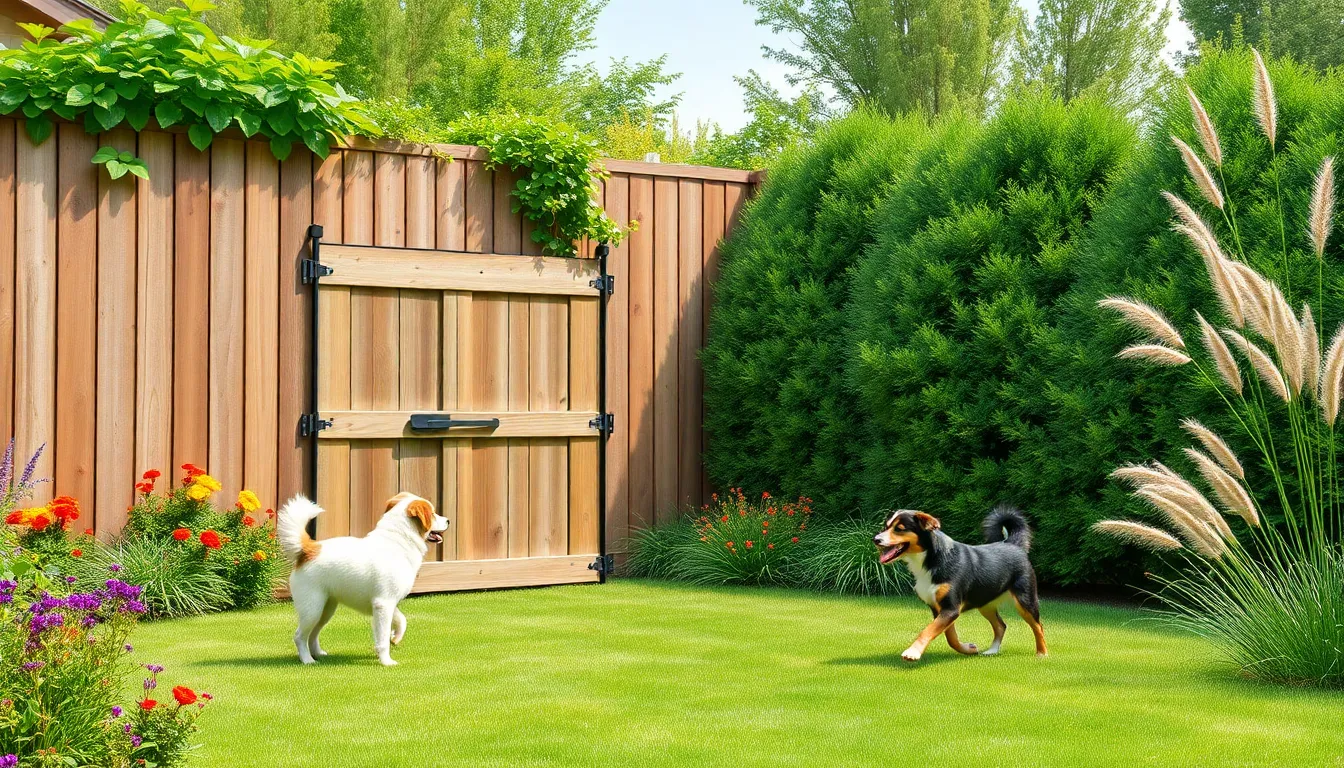
Proper fencing forms the foundation of every dog friendly garden design. We’ll explore essential boundary answers that keep our pets secure while maintaining an attractive outdoor space.
Choose Height-Appropriate Fencing Materials
Height-appropriate fencing prevents escapes and creates a secure environment for our dogs. Larger dogs and strong jumpers benefit from taller barriers that match their athletic abilities, while small dogs might be contained with standard garden edging or lightweight wire fencing. We recommend measuring our dog’s jumping height and adding at least 2 feet to determine the minimum fence height needed.
Material selection directly impacts fence durability and effectiveness. Vinyl fencing offers low maintenance and weather resistance, making it ideal for active dogs who might scratch or chew wooden surfaces. Chain link provides excellent visibility and ventilation while maintaining security, though we should choose vinyl-coated options to prevent rust and sharp edges.
Wood fencing delivers classic appeal and can be customized to match our garden’s aesthetic. Cedar and redwood naturally resist rot and insects, extending fence lifespan in outdoor conditions. We must ensure all wood treatments are pet safe and avoid pressure treated lumber that contains harmful chemicals.
Create Secure Gates and Entry Points
Gates should latch firmly and self-close to prevent accidental openings that could endanger our pets. Self-closing hinges automatically pull gates shut after we pass through, eliminating the risk of leaving them open during busy gardening sessions. Magnetic latches provide additional security by creating a strong seal that curious dogs can’t easily manipulate.
Double gates offer extra security in busier areas where multiple people frequently enter and exit. We can install these systems at main entrances or areas where delivery personnel regularly access our property. The first gate creates a containment area while we open the second, preventing dogs from rushing past us.
Gate positioning matters as much as the hardware we choose. We should install gates away from corners where dogs might gain leverage to jump over, and ensure adequate clearance prevents paws from getting caught underneath. Spring hinges work well for lightweight gates, while heavy duty options require adjustable hinges that we can fine tune for proper closing action.
Add Visual Barriers for Privacy and Comfort
Visual barriers enhance comfort and privacy for both dogs and owners while reducing external distractions. Dense shrubs like arborvitae create natural screening that grows denser over time, providing year round coverage that blocks sight lines to neighboring properties. Camellias offer beautiful blooms alongside their screening capabilities, adding ornamental value to our boundary plantings.
Ornamental grasses establish effective visual barriers while requiring minimal maintenance once established. We can plant these in groups to create natural privacy screens that move gracefully in the breeze and provide texture contrast to solid fencing. These grasses must be non-toxic and sturdy enough to withstand occasional rough play or digging from curious pets.
Solid fencing or lattice panels covered in climbing plants provide immediate visual screening from outside activity. We can install these barriers in strategic locations where our dogs tend to get overstimulated by passing pedestrians or wildlife. Climbing roses, clematis, or honeysuckle create beautiful living walls that soften hard fence lines while maintaining the screening we need for sensitive dogs.
Provide Adequate Shade and Shelter Options
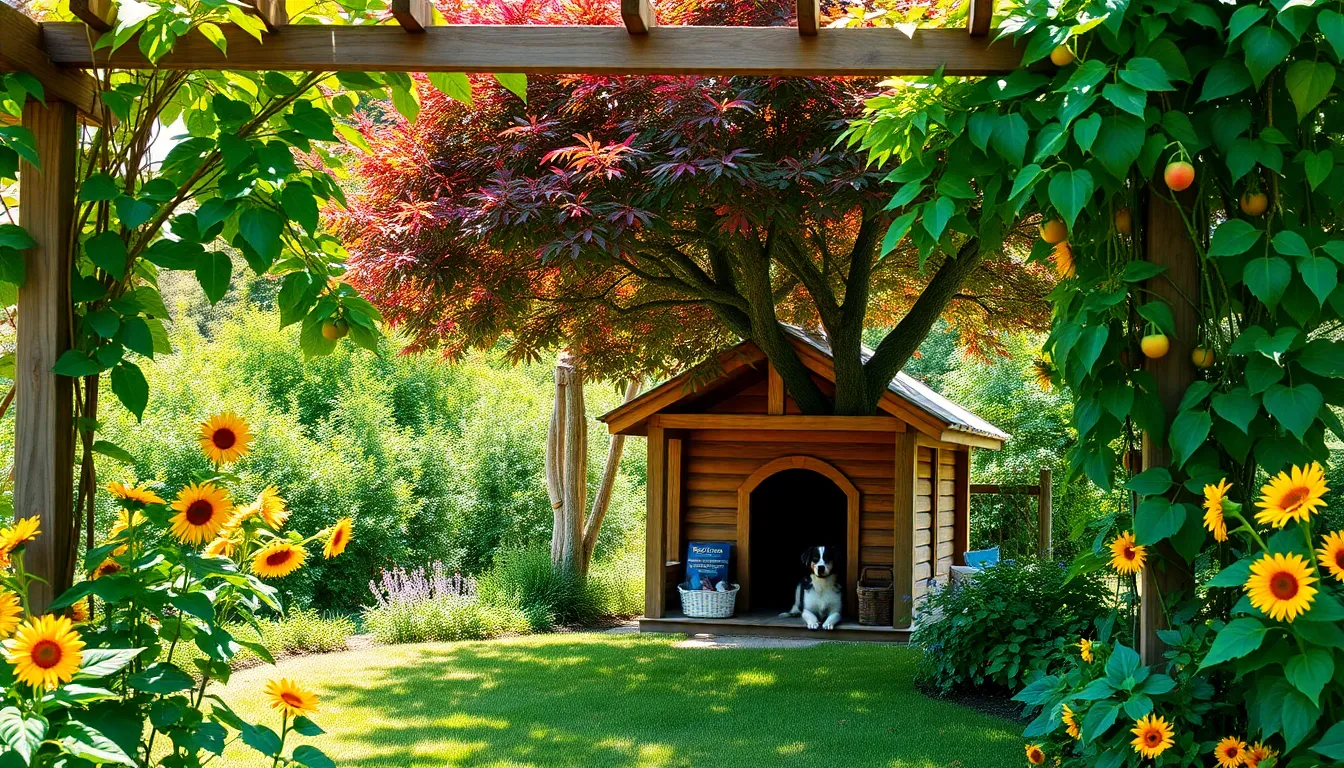
Creating comfortable shelter spots throughout your garden ensures your dog stays cool and protected during outdoor activities. We’ll explore several effective approaches to establish these essential comfort zones.
Plant Trees for Natural Cooling
Japanese maples offer exceptional natural shade while adding stunning visual appeal to your garden industry. These elegant trees create cooling microclimates that can reduce ground temperature by up to 10 degrees Fahrenheit during summer months. We recommend planting them in strategic locations where your dog spends the most time.
Magnolias provide dense canopy coverage that shields pets from harsh sunlight throughout the day. Their broad leaves create substantial shade zones that remain consistent as the sun moves across the sky. Plant these trees at least 15 feet from your home’s foundation to allow proper root development and maximum shade benefits.
Positioning trees near your dog’s favorite lounging spots maximizes their cooling effectiveness. Consider your pet’s daily movement patterns when selecting planting locations. We suggest creating multiple shaded areas across your garden to provide options throughout different times of day.
Install Pergolas and Gazebos
Pergolas create defined outdoor rooms that offer flexible shade coverage for both dogs and humans. These structures provide immediate overhead protection while allowing air circulation underneath. We recommend cedar or pressure treated lumber for durability against weather elements.
Gazebos establish permanent shelter areas that withstand various weather conditions year round. Their enclosed design offers superior protection from rain, wind, and intense sunlight compared to open structures. Install these features in areas with level ground and proper drainage to ensure longevity.
Incorporating climbing vines on pergola structures enhances shade density naturally over time. Dog safe options like Virginia creeper or Boston ivy create living walls that improve cooling effectiveness. These additions also contribute to your garden’s aesthetic appeal while serving functional purposes.
Create Covered Rest Areas with Dog Houses
Dog houses positioned under existing tree canopies provide double layer protection from heat and precipitation. This strategic placement combines natural and artificial shelter for maximum comfort. We suggest elevating dog houses slightly off the ground to improve air circulation and prevent moisture buildup.
Building covered areas near gazebos extends your outdoor living space while accommodating your pet’s needs. These integrated designs create cohesive shelter zones that serve multiple purposes throughout your garden. Consider adding comfortable bedding or cooling mats inside these areas during warmer months.
Surrounding rest areas with dog friendly plants like sunflowers and edible fruits enhances the overall environment. These plantings provide additional visual barriers and natural enrichment opportunities for curious pets. We recommend maintaining clear sight lines from rest areas to main activity zones so dogs can monitor their territory comfortably.
Incorporate Water Features for Hydration and Fun
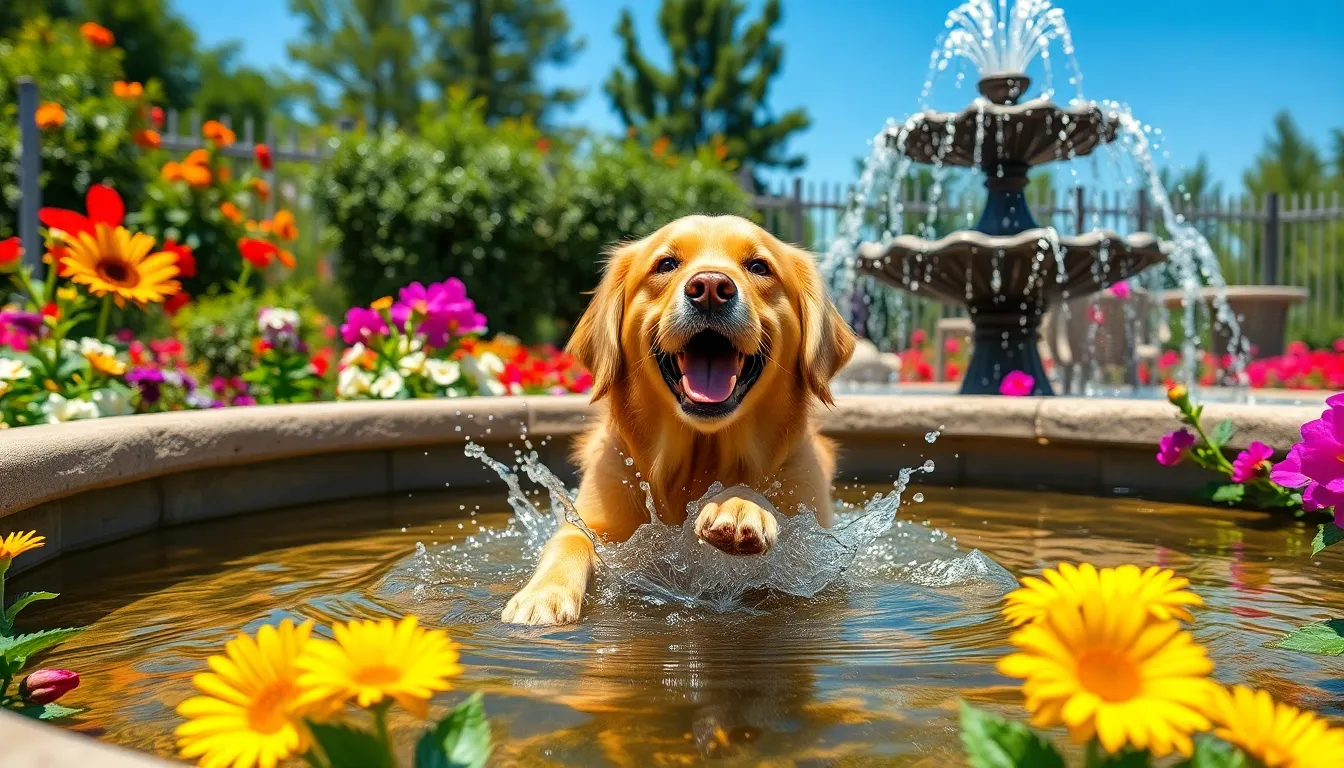
Water features serve as essential additions to dog-friendly gardens, providing both practical hydration answers and entertaining play opportunities. Dogs naturally gravitate toward water sources, making these features valuable investments for their health and happiness.
Add Shallow Wading Pools or Fountains
Shallow wading pools create perfect cooling stations where dogs can splash and play during warm weather. We recommend selecting durable, pet-safe materials that withstand regular use and provide easy access points for dogs of all sizes. Pool edges should remain low enough for comfortable entry and exit, preventing any safety concerns during playtime.
Fountains offer dual benefits by serving as both decorative garden elements and functional drinking stations for our pets. Running water encourages dogs to stay hydrated while adding visual interest to outdoor spaces. Choose fountain models with stable, weighted bases to prevent tipping accidents, and ensure the water flow remains gentle enough for comfortable drinking.
Regular water refreshing prevents stagnation and maintains cleanliness in both wading pools and fountain systems. Fresh water stays more appealing to dogs and reduces bacterial growth that could pose health risks.
Install Automatic Water Dispensers
Automated water dispensers guarantee consistent access to clean drinking water throughout the day. These devices prove particularly valuable in larger garden spaces where dogs might wander far from traditional water bowls. High-temperature climates make automatic dispensers essential for preventing dehydration during extended outdoor play sessions.
Look for dispensers featuring spill-proof designs that minimize water waste and prevent muddy areas around drinking stations. Easy refill access ensures we can maintain proper water levels without complicated disassembly procedures. Gravity-fed models often provide reliable operation without requiring electrical connections.
Create Natural Pond Areas with Safe Access
Natural ponds add beautiful focal points to dog-friendly gardens while providing swimming opportunities for water-loving breeds. Design shallow entry points with non-slip surfaces that allow dogs to wade gradually into deeper water. Gentle slopes prevent sudden depth changes that might startle or endanger smaller dogs.
Maintain pond water quality by removing harmful algae and avoiding toxic aquatic plants that could poison curious pets. Consider installing protective barriers around deeper sections to prevent unsupervised access, especially for households with puppies or non-swimming breeds.
Strategic placement keeps water features shaded during peak sun hours, maintaining cooler water temperatures that encourage regular drinking. Monitor all water areas regularly for debris accumulation and remove any waste promptly to preserve water quality and garden aesthetics.
Use Dog-Friendly Ground Covering Materials
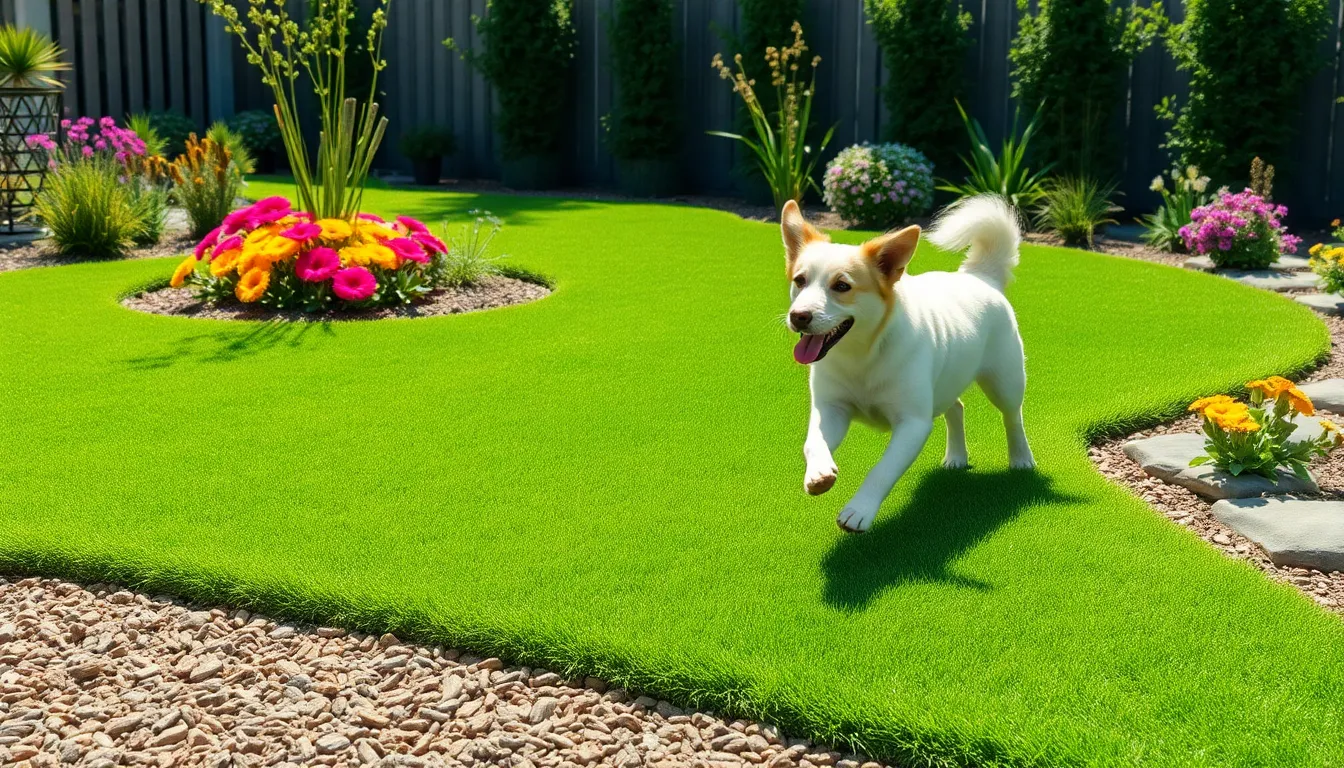
Creating the right foundation for your dog-friendly garden starts with selecting ground covering materials that balance durability, safety, and visual appeal. We’ll explore three essential approaches to ensure your garden surfaces can handle active pets while maintaining their beauty.
Select Durable Grass Varieties That Withstand Wear
Bermuda grass stands out as our top recommendation for dog owners who want resilient turf that bounces back from heavy foot traffic. This variety tolerates frequent running, playing, and digging while maintaining its lush appearance throughout the growing season. Buffalo grass provides another excellent option, offering superior drought resistance and requiring less maintenance than traditional lawn varieties.
These hardy grass types recover quickly from pet damage and establish deep root systems that prevent bare patches from forming. We recommend overseeding high-traffic areas in early spring to maintain thick coverage throughout the year. Both varieties handle urine spots better than delicate grass types, reducing the need for frequent reseeding.
Install Artificial Turf in High-Traffic Areas
Artificial turf delivers the ultimate low-maintenance solution for zones where your dogs spend most of their outdoor time. This synthetic option eliminates muddy paws during rainy seasons while providing consistent traction for safe play and exercise. Modern artificial grass varieties feature antimicrobial properties that resist odors and bacteria buildup from pet waste.
Installation in designated play areas reduces overall maintenance costs since you won’t need regular watering, mowing, or fertilizing in these sections. We suggest choosing products with adequate drainage systems to handle pet urine effectively. Quality artificial turf can last 15-20 years with proper care, making it a worthwhile investment for busy dog owners.
Choose Safe Mulch and Decorative Stone Options
Wood chips and pine straw create safe, natural ground coverings that provide excellent drainage while staying comfortable under your dog’s paws. These materials break down gradually, enriching soil quality without posing ingestion risks to curious pets. Sand offers another pet-safe option that’s particularly useful around water features and play areas.
We strongly advise against cocoa mulch, which contains compounds that can be toxic to dogs if consumed. Decorative stones should be large enough to prevent accidental swallowing – aim for pieces larger than your dog’s mouth. River rocks and flagstone create attractive pathways while remaining safe for pets to walk across during their daily adventures.
Plan Strategic Bathroom and Relief Zones
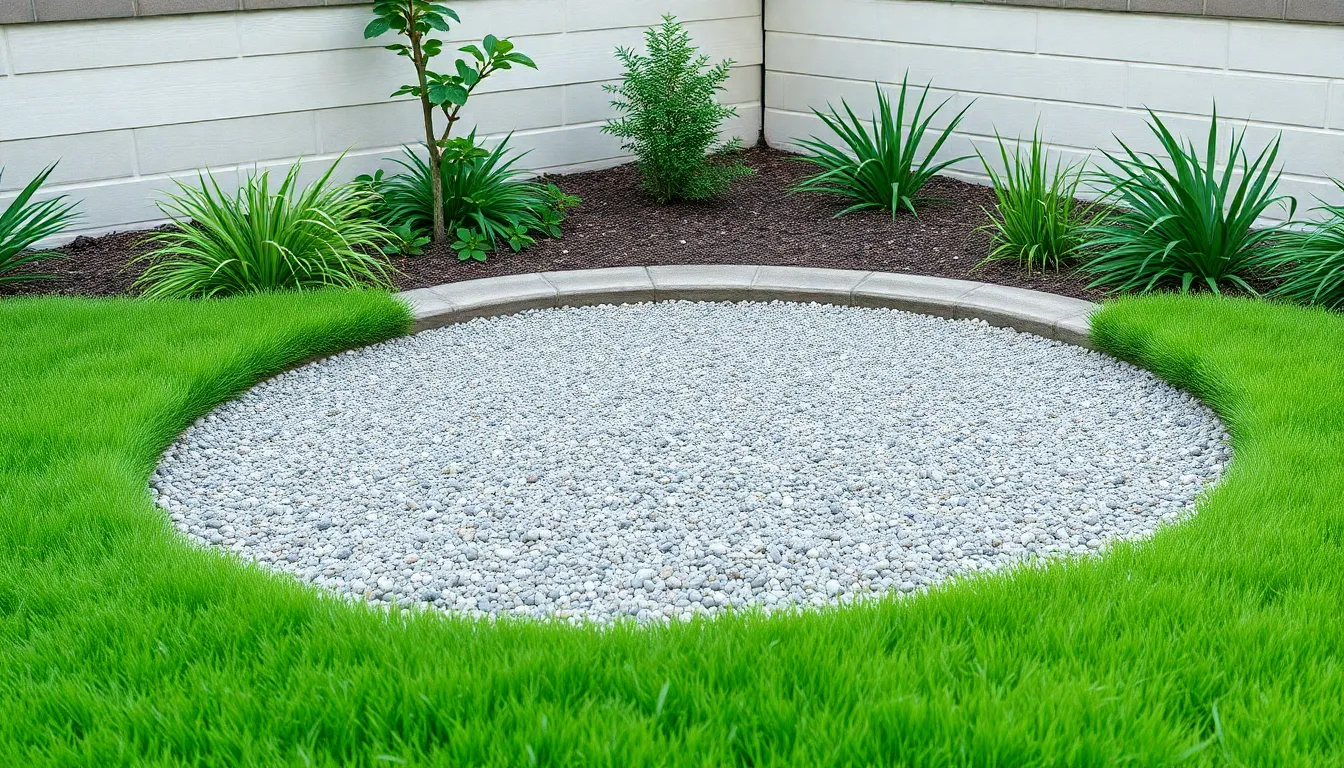
Building on our foundation of safe pathways and ground covering materials, we’ll now establish dedicated bathroom areas that protect your garden’s beauty while maintaining cleanliness and hygiene.
Designate Exact Potty Areas with Proper Drainage
Allocate a designated zone in your garden specifically for your dog’s bathroom needs to prevent random elimination throughout your landscaping. We recommend positioning this area away from entertaining spaces and children’s play zones but within easy access from your home’s main exit points.
Install proper drainage systems using materials like gravel or coarse sand that allow liquid waste to filter through quickly while preventing water accumulation. According to drainage experts, a 6-inch layer of pea gravel topped with 2 inches of sand creates optimal drainage conditions that eliminate standing water and reduce odor buildup.
Size your potty zone appropriately based on your dog’s breed and frequency of use, with small dogs requiring approximately 4×4 feet while larger breeds need 6×8 feet or more. Multiple dog households should increase these dimensions by 50% to accommodate all pets comfortably without overcrowding the designated space.
Use Odor-Controlling Ground Materials
Incorporate natural odor-absorbing materials like cedar wood chips or pine straw in your designated potty areas to neutralize unpleasant smells before they spread throughout your garden. These organic materials break down slowly while continuously releasing fresh scents that mask waste odors effectively.
Layer zeolite granules beneath your chosen ground cover material to create an additional odor-fighting barrier that absorbs ammonia from pet urine. Professional landscapers recommend applying a 1-inch layer of zeolite every 3-4 months to maintain maximum odor control effectiveness.
Replace ground materials regularly to prevent saturation and bacterial buildup that can create persistent odor problems even though your best maintenance efforts. Wood chips typically require replacement every 6-8 weeks, while pine straw needs refreshing every 4-6 weeks depending on usage frequency and weather conditions.
Create Easy-to-Clean Surfaces
Install smooth, non-porous surfaces like concrete pavers or natural stone tiles around your designated potty areas to enable quick cleanup with garden hoses or pressure washers. These materials resist staining and don’t absorb liquids, making daily maintenance simple and efficient.
Choose interlocking concrete pavers with subtle textures that provide traction for your dog while remaining smooth enough for easy waste removal and sanitization. We suggest selecting neutral colors like gray or tan that won’t show stains as readily as lighter alternatives.
Position removable rubber mats in high-traffic areas within your potty zone to protect permanent surfaces while creating additional cleaning convenience. Commercial-grade outdoor mats can be lifted, hosed down, and disinfected separately from your main hardscaping elements.
Conclusion
Creating a dog-friendly garden doesn’t mean sacrificing beauty or functionality. We’ve shown you how thoughtful planning and smart design choices can transform your outdoor space into a paradise that works for both you and your furry companions.
From selecting non-toxic plants to installing proper drainage systems every element contributes to a harmonious environment. The key lies in understanding your dog’s exact needs while maintaining the aesthetic appeal you desire.
Your garden can become a testament to the perfect balance between pet safety and stunning industry design. With these strategies in place you’ll enjoy countless hours watching your dogs thrive in their custom-designed outdoor haven.
Frequently Asked Questions
What are the most important features to include in a dog-friendly garden?
A dog-friendly garden should include non-toxic plants, designated play areas, secure fencing, adequate shade and shelter, water features for hydration, and dedicated bathroom zones. Safe pathways with non-slip materials are essential, along with durable ground coverings that can withstand pet traffic. These features ensure both safety and enjoyment for your dogs while maintaining garden beauty.
Which plants are safe for dogs in a garden setting?
Safe plants for dogs include Camellias, Magnolias, Shrub roses, Japanese Maples, and ornamental grasses. Edible options like carrots and green beans are also dog-friendly. Always avoid toxic plants such as Azaleas, Oleander, and certain lilies. Research any plant’s toxicity before adding it to your garden to ensure your pet’s safety.
How do I create safe pathways for my dog in the garden?
Install non-slip stepping stones made from textured materials, spaced appropriately for your dog’s size. Design wide gravel or mulch trails to accommodate multiple dogs comfortably. Add soft ground cover plants along main routes for paw comfort and visual appeal. Use only pet-safe materials and ensure pathways are wide enough for easy navigation.
What type of fencing works best for dog-friendly gardens?
Choose height-appropriate fencing based on your dog’s jumping ability. Vinyl offers durability, chain link provides visibility, and wood adds aesthetic appeal. Install secure, self-closing gates and consider visual barriers like dense shrubs or ornamental grasses for added privacy. Proper fencing prevents escapes while maintaining the garden’s beauty and your dog’s security.
How can I provide adequate shade and shelter for my dog?
Plant shade trees like Japanese Maples and Magnolias for natural cooling. Install pergolas or gazebos for flexible shelter options. Create covered rest areas with strategically placed dog houses under tree canopies. Surround these areas with dog-friendly plants to enhance the environment while ensuring your pet stays cool and comfortable during outdoor activities.
What water features are suitable for dogs?
Install shallow wading pools and fountains with durable, pet-safe materials and easy access. Consider automatic water dispensers for consistent hydration in larger spaces. Natural pond areas with gentle slopes and non-slip surfaces work well too. Regular maintenance is crucial to prevent stagnation and ensure water cleanliness for your dog’s health and safety.
What ground covering materials work best with dogs?
Durable grass varieties like Bermuda and Buffalo grass withstand heavy foot traffic and recover quickly. Artificial turf offers low maintenance and consistent traction while eliminating muddy paws. For decorative elements, use safe mulch options and avoid toxic materials like cocoa mulch. Choose stones large enough to prevent accidental swallowing by curious dogs.
How do I set up a designated bathroom area for my dog?
Create specific potty zones away from entertaining spaces with proper drainage using gravel or coarse sand. Size the area based on your dog’s breed and usage frequency. Use odor-controlling materials like cedar wood chips or zeolite granules. Install easy-to-clean surfaces with smooth, non-porous materials for efficient maintenance and hygiene.

